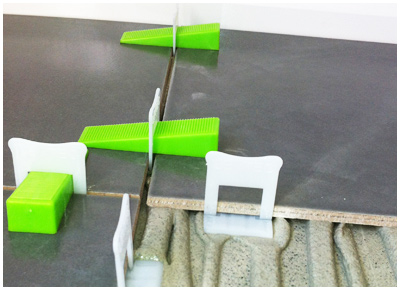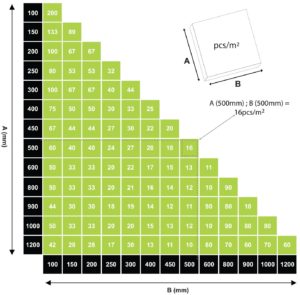
In recent years tile levelling systems have led to a revolution in tiling, with very few professional tilers unaware of this innovative option. There are various levelling systems available on the market, with each product designed to create evenly spaced and level tiles. In this blog, we will take a closer look at the how these systems work, and the advantages and the disadvantages through a series of questions and answers.
What is a tile levelling system?
The majority of levelling systems include two pieces, a clip and a wedge, which are designed to compress the tiles. The clip acts as a tile spacer and will enable the wedge to apply the pressure required to level the adjoining tiles. A clip is inserted below a tile and the bordering tile is then set on top of the clip base, the wedge then slots into the clip and sits above the two tiles. The pieces can then be adjusted using pliers to create a level surface.
Essentially, the system is designed to pull the tiles from below, whilst also providing downward pressure. The result is a perfectly level and evenly spaced tiled surface, with installation times reduced.
How many clips and wedges will I require per square metre of tiling?
The useful chart below will help you to calculate how many clips and wedges you will need per square metre of tiling when using our LevTec levelling kit. Simply find your tile size via the vertical and horizontal black rows, where the two lines intersect this will give you the number of required pieces.

How are the clips and wedges removed?
Once the adhesive sets, the reusable wedge can be removed using a rubber mallet on walls, or with your foot for tiles laid on the floor. The clip has a breakpoint below the tile surface, so once the clip is dislodged, the joint will be ready for grouting. Simply hit the clip in the direction of the tile joint and it was easily break away.
Are tile levelling wedges reusable?
Yes, the wedges are reusable, however you will need to dispose of the clips after their first use. It is worth investing in a quality wedge, as those which are resistant to wear and tear will last for a number of projects.
Will a tile levelling system save time?
Yes, tile levelling systems are designed to ensure a perfect outcome, so there is no need to remove and relay uneven tiles. Not only does this save time, but it also reduces wastage and minimises labour costs.
Apart from clip and wedge systems are there any other tile levelling systems?
The clip and wedge systems are the most popular options available, although there are also cap and post systems. These systems require a cap to be threaded onto a post, where the base of this post sits below the tile surface. Once the adhesive sets, the cap can be spun off and the post can be snapped off.
What is tile lippage?
During tiling it is not uncommon to find irregularities in the tiles and the substrate below, with any bumps creating a potential lippage issue. If the tile is able to shrink or bow over an uneven surface, the result will be a lip at the edge of the tile. Not only does this lip look unsightly, but it will also reduce bonding, increase the chances of breakages and it can be difficult to maintain.
Do I need to use a tile levelling system?
A tile levelling system will help you to finetune tile levels, so that you create a perfectly smooth finish, whilst also alleviating many of the issues associated with large format and wood-effect plank tiles. When you consider the potential irregularities in substrates and tiles, the best way to ensure excellent bonding without lippage is by using a tile levelling system.
As an exclusive supplier of LevTec products, we continue to receive excellent feedback from our valuable customers. We operate on a trade only basis through our network of stockists within the UK and Ireland, if you would like to stock these LevTec products, or would like to find your nearest stockist, please contact us today.

